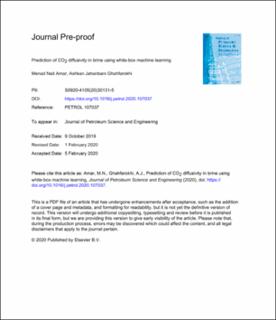| dc.contributor.author | Nait Amar, Menad | |
| dc.contributor.author | Jahanbani Ghahfarokhi, Ashkan | |
| dc.date.accessioned | 2021-03-17T06:08:34Z | |
| dc.date.available | 2021-03-17T06:08:34Z | |
| dc.date.created | 2020-04-10T20:42:05Z | |
| dc.date.issued | 2020 | |
| dc.identifier.citation | Journal of Petroleum Science and Engineering. 2020, 190 . | en_US |
| dc.identifier.issn | 0920-4105 | |
| dc.identifier.uri | https://hdl.handle.net/11250/2733780 | |
| dc.description.abstract | Accurate knowledge of the diffusivity coefficient of CO2 in brine has a significant effect on the design success and monitoring of CO2 storage in saline aquifers, which is a part of carbon capture and sequestration (CCS). Frequently applied experimental approaches for determining this parameter are expensive and time-consuming, and empirical models cannot ensure accurate predictions. Therefore, there is a need to establish cutting-edge correlations for prediction of the diffusivity coefficient of CO2 in brine under various operating conditions. In this work, two white-box machine learning techniques, namely group method of data handling (GMDH) and gene expression programming (GEP) were implemented for correlating the diffusivity coefficient of CO2 in brine with pressure, temperature and the viscosity of the solvent. The obtained results demonstrated the accuracy of the proposed correlations. In addition, statistical and graphical analysis of the performances revealed that GEP correlation outperforms the GMDH correlation, decision trees (DTs), random forest (RF) and all the previous predictive models. GEP correlation exhibited an overall average absolute relative deviation (AARD) of 4.3014% and coefficient of determination (R2) of 0.9979. Finally, by performing the outliers detection, the validity of the GEP correlation was confirmed and only two experimental data points were identified as outliers. | en_US |
| dc.language.iso | eng | en_US |
| dc.publisher | Elsevier | en_US |
| dc.rights | Attribution-NonCommercial-NoDerivatives 4.0 Internasjonal | |
| dc.rights.uri | http://creativecommons.org/licenses/by-nc-nd/4.0/deed.no | |
| dc.title | Prediction of CO2 diffusivity in brine using white-box machine learning | en_US |
| dc.type | Peer reviewed | en_US |
| dc.type | Journal article | en_US |
| dc.description.version | acceptedVersion | en_US |
| dc.source.pagenumber | 15 | en_US |
| dc.source.volume | 190 | en_US |
| dc.source.journal | Journal of Petroleum Science and Engineering | en_US |
| dc.identifier.doi | 10.1016/j.petrol.2020.107037 | |
| dc.identifier.cristin | 1805830 | |
| dc.description.localcode | "© 2020. This is the authors’ accepted and refereed manuscript to the article. Locked until 8.2.2022 due to copyright restrictions. This manuscript version is made available under the CC-BY-NC-ND 4.0 license http://creativecommons.org/licenses/by-nc-nd/4.0/ | en_US |
| cristin.ispublished | true | |
| cristin.fulltext | postprint | |
| cristin.qualitycode | 2 | |

